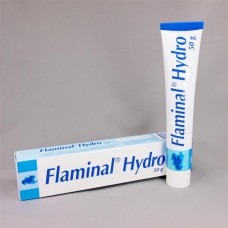FLAMINAL HYDRO 50G
GENERAL INFORMATION
Flaminal Hydro (and Forte) are advanced technology wound care products. They are classified as enzyme alginogels – hydrated alginates with an embedded anti-bacterial enzyme system.
Flaminal support the healing of wounds via :
· A moist wound healing environment;
· Continuous auto-debridement &
· Anti-bacterial activity
Flaminal’s antibacterial properties rely on the action of two naturally occurring enzymes:
* Glucose oxidase, also found in honey &
* Lactoperoxidase, produced by mammals in tears, mucous and milk
Bacteria and exudate from the wound are absorbed into the Flaminal gel;
Glucose oxidase in the Flaminal converts the available glucose, oxygen & water from the wound exudate into peroxide ions;
The peroxide ions are captured by the lactoperoxidase in the Flaminal and converted into reactive oxygen species (ROS);
The lactoperoxidase then selectively binds to the bacterial cell wall where it releases the reactive oxygen species which penetrate the cell wall of the bacteria and kill it.
How to Use
1. ASSESS THE WOUND.
Select between Flaminal Hydro and Flaminal Forte based on the amount of exudate.
Choose Flaminal Hydro for wounds that are dry or have mild to moderate amounts of exudate. This generally means wounds in which the dressing can stay in place for 3-4 days. (Choose Flaminal Forte for wounds that have moderate to heavy amounts of exudate. Flaminal Forte wounds are generally changed every 1-2 days).
2. APPLY THE FLAMINAL
Clean and rinse the wound as you would normally.
Dab dry carefully.
Apply a thick layer (5mm) of Flaminal Hydro (same for forte) to the wound in a sterile manner. Flaminal does not need to spill over the wound edge.
3. DRESS THE WOUND
Dress according to the amount of exudate and choose a dressing that does not have anything additional embedded within it.
Choose an absorbent dressing for wetter wounds.
On drier wounds, use a dressing that reduces evaporation and prevents the wound from drying out.
4. CHANGE THE DRESSING
The dressing can stay in place for as long as the gel structure is intact: 1-4 days, depending upon the amount of exudate.
For wounds treated with Flaminal Hydro, ie, lower exudate wounds, this generally means every 3-4 days. Flaminal Forte wounds, being higher in exudate, are usually changed every 1-2 days.
Recommendations
Change from Flaminal Forte to Flaminal Hydro as exudate reduces.
When using Flaminal Hydro, if the gel becomes too liquid, the wound is too wet for Flaminal Hydro. Use Flaminal Forte.
When using Flaminal Forte, if dry flakes of alginate appear in the wound, the wound is too dry for Flaminal Forte. Use Flaminal Hydro.
During Flaminal treatment, dry whitish alginate flakes may appear on the wound border. They should not be removed. The flakes will prevent border maceration. Maceration slows the healing process.
As this is a selective process, only absorbed bacterial cell walls are destroyed and not the cell walls of human cells within the wound bed, such as keratinocytes and fibroblasts.
Tags: Wound Management, Wound Dressings, Hydrocolloids, Skin Care

